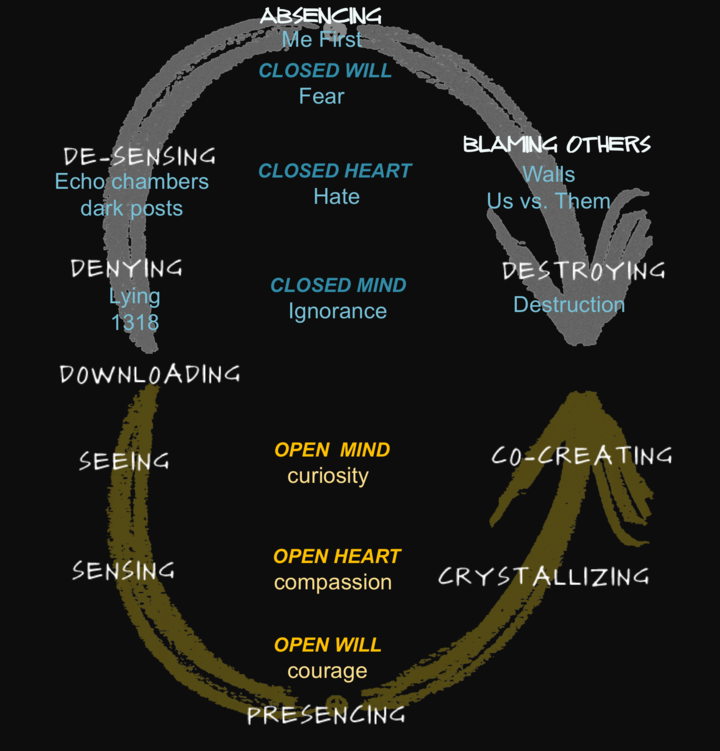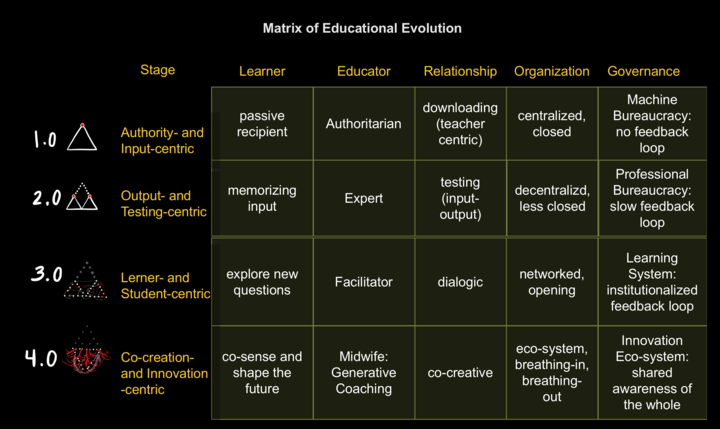By Otto Scharmer, originally published by HuffPost
“Trump is America’s wake-up call” I heard a visitor to the United States say the other day. True. Trump’s first year has been a wake-up call heard around the world. But are we really waking up? And who is “we”? And what, if anything, is the new awareness that we are supposed to wake up to?
This column inquires into these questions, and announces a major initiative that blends the news and social media power of HuffPost with the online-to-offline movement-building capacities of MITx u.lab.
Over the past few months, having attended events and grassroots gatherings in various parts of the world, I’m encouraged that such a waking-up and movement building process is well underway. I’ve seen firsthand a new landscape of initiatives focused on transforming the foundations of our economies and our social structures that is emerging. At the same time, social media movements such as #MeToo have shown how quickly latent and necessary changes can be catalyzed in our current moment.
While there is still much more structural and systemic work to be done, it’s increasingly clear that as our old economic structures and civilizational forms hit the wall of our planetary limits, a new world is taking shape that focuses on bridging the three major divides of our time: the ecological divide, the social-economic divide, and the spiritual divide.
This awakening process is not only happening in grassroots movements. It’s equally observable among many, particularly younger, leaders working inside our traditional institutions. Everyone knows that we live in a moment of profound disruption. An old order is about to end. And something new is about to be born.
Last week, I was running a session at the European Central Bank in Frankfurt. During the discussion, one of the senior management attendees said: “The problem you describe is not totally new. The destructive dynamics of prejudice, ignorance, hate, and fear have been around for a long time.” And then he asked, “But why is it so much worse today? What is actually different now?”
What a great question. It prompted me to deepen my own sense making.
The Three Responses to Disruption
In earlier columns, I have framed the global politics of our present moment in terms of three different responses to disruption that are playing out in all sectors and systems:
- Muddling through: downloading (maintaining the status quo),
- Moving backward:“making X great again”,
- Moving forward:leaning into the unknown to co-sense and co-create the future.

Response 1: Muddling through—what the 2017 elections really tell us
The first response just extends the status quo: business as usual. As Hillary Clinton’s loss in 2016 and the recent elections across Europe have demonstrated, the mainstream option is increasingly unattractive and unacceptable to the majority of voters. The mainstream parties in the Dutch, French, German, and Austrian elections this year have lost by greater margins than the right right-wing parties have gained.
In the United States we see this outcome mirrored in the 2016 presidential primaries: the anti-mainstream candidates, Trump and Sanders, gained much more support than the candidates endorsed by the party establishment (Bush and Clinton). The reason Sanders did not make it onto the ticket was because of the manipulative influence of the Clintons and their foundation on the operations of the Democratic National Committee.
In other words, the main story of the past year is not just the rise of the far right but the decline of the mainstream status quo parties combined with a failure of the entire political system to generate any viable alternative to the mainstream option other than the outdated ideologies of yesterday (nationalism) or the day before yesterday (white supremacy).
Response 2: Moving backward
The second response says that the system is broken and that we need to “drain the swamp” by orienting ourselves backward. This response is much more radical than muddling through. It connects to the felt sense of frustration. But it operates on the closing of the mind, heart, and will, i.e., the amplification of prejudice, ignorance, hate, and fear. As filmmaker Michael Moore put it so succinctly: “Ignorance creates fear, fear creates hate.” The five main behaviors of this cycle include:
Denial: Not seeing what is going on. Example: This year, the United States has been hit by one “worst ever” hurricane after another. What conversation are we nothaving? The conversation about climate change. There is more than one mass shooting every day (on average), but what conversation are we nothaving? The conversation about gun laws. That’s what denial looks like on a societal level. Denial is reinforced through the politics of lying. Since Donald Trump took office, he’s made at least 1,318 false or misleading statements (but by the time you read this the actual number will be higher.)
De-sensing: Being unable to empathize with others. Donald Trump is the living embodiment of that condition. But Trump is only the symptom. The deeper problem includes a broader loss of empathy in society. The amplification mechanisms here include digital echo chambers within social media and the use of micro-targeting and dark posts, designed to stir up hate and fear across racial and other divides, funded by the Russian government and by U.S. billionaires like Robert Mercer.
Absencing: Losing the connection to one’s emerging future self—that is, getting stuck in the rigid identities of the past, getting stuck inside one’s ego boundaries: Me First!
Blaming others: The inability to reflect on one’s own role. Blaming others deepens and hardens the dynamics of “Us vs. Them” and results in delusional fantasies about building walls against outsiders that keep us trapped into an architecture of separation.
Destruction: The outcomes of this cycle result in the destruction of nature (pulling out of the Paris climate agreement, disabling the Environmental Protection Agency), the destruction of trust and the undermining of international institutions (UN, NATO, the Iran nuclear deal), and the destruction of institutions like healthcare that keep our societies together.
The United States isn’t the only country dealing with these things. There is a cycle of destruction and self-destruction observable in many systems and sectors of our civilization today. In most global systems today we collectively create results that (almost) nobody wants.
Response 3: Moving forward
The third response is perhaps the most important and least familiar. This response attends to disruption by leaning forward into the unknown, by sensing and actualizing the future that wants to emerge. To do that you need three critical capacities: listening and curiosity (an open mind), empathy and compassion (an open heart), as well as confidence and courage (an open will). If you face a moment of disruption and you lack these critical capacities, you are easily thrown into the space of absencing—that is, into a self-reinforcing dynamic of separation and destruction. Seen from this angle, we can see the rise of Trumpism and fundamentalism not only as the result of economic and political failures, but first and foremost as a massive educational failure.
Five Forces that Amplify the Cycle of Destruction
Figure 1 summarizes how our responses to disruption give rise to both of these cycles: the cycle of absencing and destruction, and the cycle of presencing and co-creation. Both cycles co-exist in society today. We know both of them well from our own behavior. They are separated only by the degree of openness in our minds, hearts, and wills as we respond to disruption. If we look across systems today, we see a lot of evidence that both these cycles exist and that both have a lot of evidence and momentum.
But why does the public conversation and public consciousness focus almost exclusively on the cycle of absencing and self-destruction? Why does the cycle of absencing and destruction dominate the public conversation—while the cycle of creation remains largely invisible and unattended to?
I see five structural forces that make what’s happening today different. Let me quickly describe them and then conclude how the destructive direction of these forces can be turned around to functioning as forces for co-creation.
1. The News and Social Media as a Noise Amplification Machine
Media and social media keep amplifying the noise and creating distractions that penetrate every corner of our private and professional lives. One of the drivers is that negative news often sells better than positive news. It’s better business for the platform. For example, it was widely reported by BuzzFeed that at the height of the 2016 U.S. election people shared more fake news stories on Facebook than they shared stories from real news sites.
Much of what the news and social media do amounts to amplifying the noise machine and magnifying society’s condition of collective ADHD (attention deficit hyperactivity disorder)—that is, jumping from one crisis flash point to another, without ever addressing any of the deeper issues involved.
Instead, we need to deepen our collective focus on the systemic root issues that underlie the symptoms. We need to close the feedback loop of collective awareness and action—that is, we need to become aware that in this age of reflexive modernity our own actions can backfire and crumble the foundations of our own system (see figure 2).

Figure 2: Reflexive Modernity seen through the German weekly Der Spiegel (“Washington, one year later”)
2.Technology: Dark Posts, Micro-Targeting, and Eco-chambers
The second structural force is technology as it currently shows up through tech giants like Facebook, Google, Amazon, and Apple. Technology was first seen as force for good. But as companies like Facebook and Google grew, they started to put their profitability and ambition for global empire building above their commitment to be a force for good. That choice has turned us, the users, from being customers to being the product that is sold to whoever pays most (i.e., right wing billionaires or the Russian government). The result is that these companies have become a force for undermining our democracy, as last week’s congressional testimony by tech executives made shockingly clear.
The use of dark posts, micro-targeting, and algorithm-based social echo-chambers are examples of how technology is now a sophisticated mechanism to manipulate voters in ways that increasingly rip our communities apart. The heightened incidence of aggression and violence within the United States is just one example. As these giant monopolistic forces increasingly dominate our lives and refuse to behave responsibly, we have to ask ourselves what future we want for our societies.
A future in which human behavior is just an extension of machine-made algorithms, or a future in which these monopolies are broken up unless they voluntarily refocus their purpose from global empire building to serving the well-being of all. If aiming for the latter, it would require the leaders of these organizations to shift their mindset from ego- to eco-system awareness, from empire building to serving a larger eco-system of societal innovation and renewal.
The final three structural forces relate to the missing update of the operating system that we use to run our economies, democracies, and educational systems.
3.Massive Economic Failure
The ever-increasing levels of inequity represent the third structural factor in our current moment of disruption. Two quick facts to illustrate this point. One, in the United States the life expectancy of the country as a whole is becoming shorter, which is extremely unusual and alarming for a highly developed country. The decline is particularly pronounced for white males with low levels of education and income—i.e., the “forgotten people” that Trump has given voice to.
Two, eight rich people in the world own as much as half of mankind combined. At the root of this massive economic failure—the four-decade-long decline of the middle class—is the neoliberal economic paradigm that promised a rising tide of wealth would lift all boats, but never delivered on that promise. Instead, the biggest of these boats just got bigger and bigger.
One of the main amplification mechanisms here, as we also learned this week through the Paradise Papers, is the tax system that allows the 0.01%, the super-rich individuals and institutions (like Apple) to engage in legal tax avoidance and re-using the same money to further (legally) bribe the political class in D.C. to even increase these same tax loopholes in the system. Which brings us to the fourth factor.
4.Dark Money and the Slow Death of Democracy
The fourth structural force concerns the creeping death of democracy that is nowhere more visible than in Washington, D.C. If you are lawmaker, you spend roughly 50 percent of your time raising money for your next election campaign. How do you do that? You go where the money is. That means you spend your time listening to the 0.01 percent and their armies of lobbyists.
Five major industries control the lion’s share of all lobbying power in Washington: Wall Street, Big pharma, Big energy, the military-industrial complex, and the Silicon Valley big data empires. The lobbying power of these industries makes sure that all major policies reflect their interests and preferences, while the will of the majority of voters is routinely ignored.
Examples: Wall Street banks roll back financial regulation and consumer protection, health care costs, already the highest in the world, keep soaring, environmental protection is being dismantled, climate change ignored, weapons are sold into crisis regions, and the right of citizens to control their own private information is almost completely ignored.
In her book Dark Money, Jane Mayer describes how the rise of Trump and the far right is the result of a long term multi-billion-dollar investment by a small group of billionaires that included to change the public perception of climate change and the creation of a movement that put the Trump administration into office to execute the five point special interest group agenda mentioned above.
Some of them have been long-term investors and funders, like the Koch brothers. Others, like Robert Mercer, only recently joined that field (by making the Breitbart media platform work for Trump messaging). The Koch brothers and friends intentionally created a climate denial industry. Over the course of just seven years, from 2003 to 2010, they invested no less than half a billion dollars in this venture. The campaign was funded by 140 conservative foundations that pooled their money and distributed $558 million in the form of 5,299 grants to ninety-one different nonprofit organizations (Dark Money, p. 251).
While it is not new that plutocrats in the United States (and elsewhere) buy political influence or entire elections, what is new is the level of professionalism in the strategic funding effort, including the pooling of resources and strategic long-term investing in high-impact individuals with influential ideas, well-known think tanks, and university programs and media infrastructures, as well as in on-the-ground movement building.
5.Massive Educational Failure
So we have some media-related issues. We have economic and political issues that relate to the lack of further evolving our economic and democratic operating systems. But what is at the even deeper source level at issue here? Education and learning. The fifth force concerns a massive failure of our educational systems.
In most educational systems, we have moved from an input orientation (1.0) to an output orientation (2.0) as outlined in figure 3.

Education 2.0 can also be described as “bulimia learning”: fast in, fast out. Information is ingested and regurgitated in standardized tests, but never has a chance to become real knowledge. While the mainstream schools have moved into 2.0 and the better schools today are moving from 2.0 to 3.0—that is, to a more student-centric architecture—only the most innovative are beginning to move into education 4.0, which focuses on activating the deeper sources of creative, professional, and human development.
Thus, the primary challenge for our educational systems is to move beyond education from 2.0 towards 3.0 and 4.0, i.e., student centric forms of learning that activate the deeper sources of creativity and knowing.
Five Forces for Remaking Our World from Within
What does it take to turn the tide of these five forces from destruction to co-creation? If we attend to it, we can see many inspiring initiatives on local, city, and sometimes state or country levels that are modelling ways of bridging the ecological, social, and spiritual divides. But only a few of them are doing so on a larger level of scale that is called for today. What does it take turn these manifold grassroots seeds into a vibrant eco-system that transforms capitalism towards social and environmental justice, towards well-being for all?
A New Initiative For Making Our Movement See Itself
One part of what it takes are new coalitions, new cross-sectional partnerships that pool our resources, networks, and capacities to serve this larger purpose. To prototype such collaborations, HuffPost is teaming up with the Presencing Institute (PI) in a joint initiative that blends the online news media reach of Huffpost with the global capacity and movement building infrastructures of PI and MITx u.lab in order to launch a joint initiative that will:
Create an interactive multimedia hub to move the new economic narrative from marginal to mainstream.
Shine a spotlight on pioneers and inspiring living examples of the new economy and the principles that guide them.
Connect aspiring change makers with the pioneers that already created inspiring living examples around the various key acupuncture point areas of transforming capitalism
Share key frameworks that link the transformation of capitalism and the upgrading our democratic and educational systems with the UN framework of the 17 SDGs (Sustainable Development Goals)
Provide methods, tools, and movement building capacities that help change makes to move from idea to action.
HuffPost has already launched a Facebook page and started reporting on New Economy topics. The main interactive multimedia learning hub is being developed now and will be launched in March 2018 on the PI website. It will include monthly, online live-broadcasts on key areas of transforming capitalism, regular digital community café’s in which change makers and movement builders connect with each other in order to form place based hubs for change, and many other features that will help change makers to move their initiative from intention to impact.
So, to return to the question of the ECB manager, why seem the forces of destruction so much more powerful than the forces of co-creation? Because the latter one’s do not have any real amplification mechanism. And that’s exactly what we are trying to build and prototype over the next few months.
The main purpose of the interactive media hub and platform is to help the emerging global movement sense and see itself across sectors, systems, and cultures. To the degree that this happens we will see the dynamics shift from destruction to creation, from absencing to presencing.
If you want to join this local-to-global movement building for awareness-based systems change, please sign up for the PI mailing list so we can keep you informed when the enabling infrastructures are ready for launch.
Thanks to Adam Yukelson and Laura Paddison for their input on this column.
Republished with permission of the author.
Featured Image/graphic link added by Enlivening Edge Magazine




